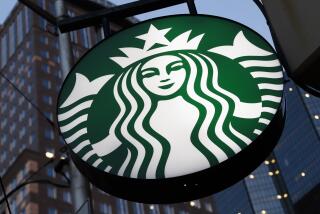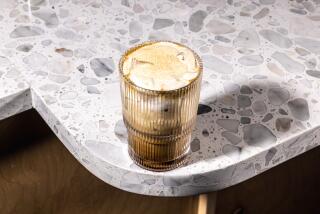Macao Slowly Wakes Up and Smells the Iced Mocha
- Share via
MACAO — For six years, the Starbucks coffeehouse chain has expanded in Asia by selling its coffee to nations of tea drinkers.
Now there’s a new challenge.
This month, the Seattle-based company opened an outlet in one of Asia’s few genuine coffee cultures--the former Portuguese colony of Macao.
“We don’t want to compete directly with the local coffeehouses,” said Pedro Man, president of Starbucks Coffee Asia Pacific Ltd. “We just want to be part of the scene.”
That it already is.
Ensconced in an elegant, brightly colored colonial home along the old cobblestone Senado Square that forms the heart of central Macao, the Chinese enclave’s newest coffee hangout--corporate flag, green logo and all--has generated considerable curiosity.
One day last week, a steady flow of local residents and tourists from mainland China warily approached the entrance and carefully eyed the invitation to “discover the Starbucks experience.”
Many of the curious appeared either too unsure or too shy to enter, but some of the 10 customers sitting at tables inside said they were already converts.
“It’s close to the office, and the quality of what you get is good,” attorney Luis Resadas said as he swilled the last of a midmorning espresso. “I’m glad they’re here. I’ll be back.”
Later in the day, the place gets busy, according to the outlet’s manager, Ivan Wong. In the afternoons and early evenings, he said, the shyness fades and lines form to sample the latest U.S. cultural export, such as an iced mocha or a frappuccino.
Still, some have already proclaimed Starbucks a one-time-only experience.
“Overpriced and not very good,” said Tony Wilkinson, a land appraiser who settled in Macao 11 years ago. “And who wants to drink coffee from a plastic cup? I want something I can hold on to.”
Owners of other coffee shops around the square don’t seem worried about the competition. They say some of their regulars tried the new place--where an espresso runs 20% to 30% more than at a local shop--but are already back.
“Starbucks is Starbucks; my coffee is different, my cakes are different,” said Mario Vale, who owns a cafe called O Barril tucked into a narrow side street off the square. It is about 100 yards and a cultural world away from the slick signs and modern decor of the new Starbucks.
“My customers are Portuguese,” he added confidently. “They’ll stay with me.”
Certainly, traditional coffee tastes in Macao are a long way from a Starbucks iced latte.
At O Barril, for example, customers prefer to sip a strong espresso. Here, Vale noted with pride, even regular coffee is run through an espresso machine. At other cafes, many older Chinese residents prefer a concoction of half tea and half espresso known as yin yeung.
But those involved in the latest Starbucks venture say it’s more about offering locals an alternative than trying to compete directly against established houses. Possibly because of this, even longtime residents who say they know little about the new arrival believe it’s probably a good thing for Macao.
Lancelot Rodrigues, the local director of Catholic Social Services, said that he will stick with his homemade blend of Timorese, Brazilian and Malaysian coffee as his preferred morning drink but that new businesses bring badly needed new jobs to the area.
“There are lots of cafes here--why not Starbucks?” he said. “They drink coffee there, don’t they?”
More to Read
Eat your way across L.A.
Get our weekly Tasting Notes newsletter for reviews, news and more.
You may occasionally receive promotional content from the Los Angeles Times.










